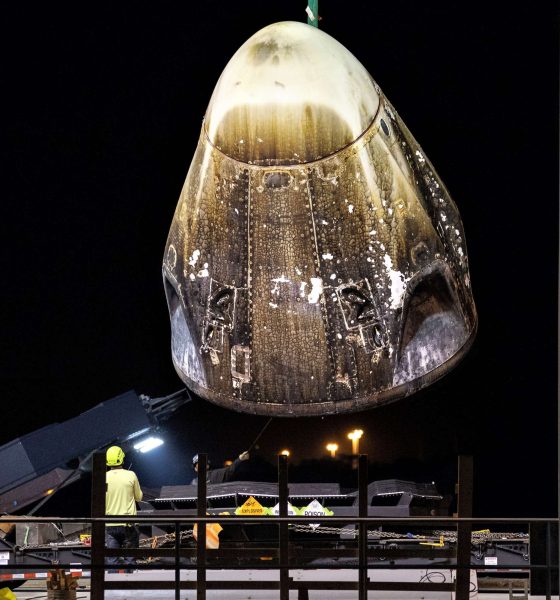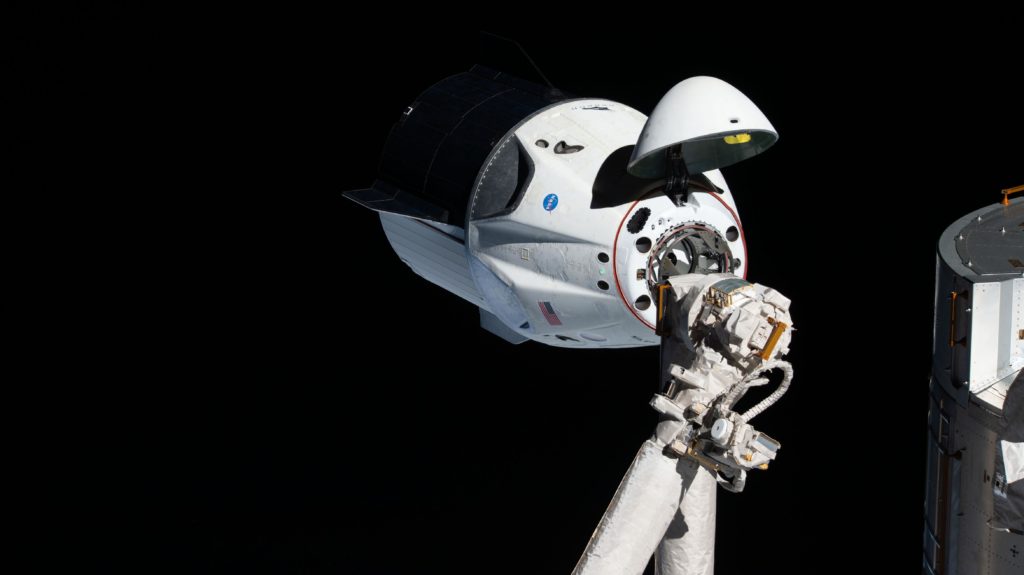

News
SpaceX’s Crew Dragon explosion investigation almost complete, says executive
Speaking at the 2019 AIAA Propulsion & Energy Forum, SpaceX Vice President of Build and Flight Reliability Hans Koenigsmann was significantly more confident that the company is just days or weeks away from wrapping up a serious Crew Dragon failure investigation.
On April 20th, flight-proven Crew Dragon capsule C201 experienced a catastrophic failure mode – largely a surprise to SpaceX – that completely destroyed the vehicle milliseconds prior to a planned static fire test. Given the obvious mortal danger such a failure would have posed to any crew aboard, SpaceX’s plans to conduct its first crewed Crew Dragon launch (Demo-2) in Q3 2019 were thrown out the window. Thankfully, Hans believes that SpaceX is just shy of concluding that investigation, “hopefully” permitting the launch of a critical abort test and Demo-2 before 2019 is out.
More specifically, Koenigsmann noted that SpaceX is currently planning to conduct a critical Crew Dragon in-flight abort (IFA) test in October or November, more or less in line with a recent report from NASASpaceflight.com that the test is targeted for November 11th, 2019. NASASpaceflight also confirmed that SpaceX still plans to fly Falcon 9 booster B1046.3 on the critical test flight, currently the only established plan to launch a thrice-flown booster, a potential first for SpaceX’s reusability program.
SpaceX’s IFA test is a continuation of the company’s suborbital Crew Dragon testing. Back in 2015, SpaceX successfully completed a pad abort test in which a low-fidelity Dragon mockup used its eight SuperDraco abort thrusters to replicate an escape from a rocket failure on the launch pad. SpaceX’s in-flight abort test will – like its namesake indicates – perform a similar test in flight, ensuring that Crew Dragon is able to safely escape from a failing Falcon 9 at Max Q, the point during launch where atmosphere-induced mechanical stress is at its peak.
In theory, demonstrating a successful pad and in-flight (Max Q) abort means that a given spacecraft is able to safely abort at all points during flight – from the pad all the way to orbit. It’s not clear if Crew Dragon is actually designed to be capable of what’s known as an “abort-to-orbit”, but the hardware is likely there if it’s needed.

On July 15th, Hans Koenigsmann and NASA Commercial Crew Program (CCP) manager Kathy Lueders went into significant detail with a preliminary Crew Dragon failure investigation update. They revealed that Crew Dragon’s April 20th explosion was traced to a likely mode, in which a “slug” of Dragon’s liquid oxidizer (nitrogen tetroxide, NTO) leaked and was subsequently smashed into a titanium valve by helium pressurized to several thousand PSI.
Said impact – effectively turning NTO into a bullet – thus created a spark in one or two ways: the titanium debris could have easily created sparks on its own, while NTO is also known to interact in violent and exotic ways with titanium under impact conditions. Either way, the fix is relatively simple (replace the valves and avoid titanium in the NTO pressurization system), but the fact that the design flaw existed in the first place serves as a much larger concern for the entirety of Crew Dragon’s joint SpaceX-NASA design and certification.
Ultimately, Hans seemed much more confident on August 19th than he was a month prior, indicating that the investigation is just shy of wrapping up. Once complete, SpaceX can complete the necessary modifications and get back on the saddle for Crew Dragon’s inaugural crewed launch and next abort test.
Check out Teslarati’s Marketplace! We offer Tesla accessories, including for the Tesla Cybertruck and Tesla Model 3.

Elon Musk
Elon Musk and Tesla AI Director share insights after empty driver seat Robotaxi rides
The executives’ unoccupied tests hint at the rapid progress of Tesla’s unsupervised Robotaxi efforts.

Tesla CEO Elon Musk and AI Director Ashok Elluswamy celebrated Christmas Eve by sharing personal experiences with Robotaxi vehicles that had no safety monitor or occupant in the driver’s seat. Musk described the system’s “perfect driving” around Austin, while Elluswamy posted video from the back seat, calling it “an amazing experience.”
The executives’ unoccupied tests hint at the rapid progress of Tesla’s unsupervised Robotaxi efforts.
Elon and Ashok’s firsthand Robotaxi insights
Prior to Musk and the Tesla AI Director’s posts, sightings of unmanned Teslas navigating public roads were widely shared on social media. One such vehicle was spotted in Austin, Texas, which Elon Musk acknowleged by stating that “Testing is underway with no occupants in the car.”
Based on his Christmas Eve post, Musk seemed to have tested an unmanned Tesla himself. “A Tesla with no safety monitor in the car and me sitting in the passenger seat took me all around Austin on Sunday with perfect driving,” Musk wrote in his post.
Elluswamy responded with a 2-minute video showing himself in the rear of an unmanned Tesla. The video featured the vehicle’s empty front seats, as well as its smooth handling through real-world traffic. He captioned his video with the words, “It’s an amazing experience!”
Towards Unsupervised operations
During an xAI Hackathon earlier this month, Elon Musk mentioned that Tesla owed be removing Safety Monitors from its Robotaxis in Austin in just three weeks. “Unsupervised is pretty much solved at this point. So there will be Tesla Robotaxis operating in Austin with no one in them. Not even anyone in the passenger seat in about three weeks,” he said. Musk echoed similar estimates at the 2025 Annual Shareholder Meeting and the Q3 2025 earnings call.
Considering the insights that were posted Musk and Elluswamy, it does appear that Tesla is working hard towards operating its Robotaxis with no safety monitors. This is quite impressive considering that the service was launched just earlier this year.
Elon Musk
Starlink passes 9 million active customers just weeks after hitting 8 million
The milestone highlights the accelerating growth of Starlink, which has now been adding over 20,000 new users per day.

SpaceX’s Starlink satellite internet service has continued its rapid global expansion, surpassing 9 million active customers just weeks after crossing the 8 million mark.
The milestone highlights the accelerating growth of Starlink, which has now been adding over 20,000 new users per day.
9 million customers
In a post on X, SpaceX stated that Starlink now serves over 9 million active users across 155 countries, territories, and markets. The company reached 8 million customers in early November, meaning it added roughly 1 million subscribers in under seven weeks, or about 21,275 new users on average per day.
“Starlink is connecting more than 9M active customers with high-speed internet across 155 countries, territories, and many other markets,” Starlink wrote in a post on its official X account. SpaceX President Gwynne Shotwell also celebrated the milestone on X. “A huge thank you to all of our customers and congrats to the Starlink team for such an incredible product,” she wrote.
That growth rate reflects both rising demand for broadband in underserved regions and Starlink’s expanding satellite constellation, which now includes more than 9,000 low-Earth-orbit satellites designed to deliver high-speed, low-latency internet worldwide.
Starlink’s momentum
Starlink’s momentum has been building up. SpaceX reported 4.6 million Starlink customers in December 2024, followed by 7 million by August 2025, and 8 million customers in November. Independent data also suggests Starlink usage is rising sharply, with Cloudflare reporting that global web traffic from Starlink users more than doubled in 2025, as noted in an Insider report.
Starlink’s momentum is increasingly tied to SpaceX’s broader financial outlook. Elon Musk has said the satellite network is “by far” the company’s largest revenue driver, and reports suggest SpaceX may be positioning itself for an initial public offering as soon as next year, with valuations estimated as high as $1.5 trillion. Musk has also suggested in the past that Starlink could have its own IPO in the future.
News
NVIDIA Director of Robotics: Tesla FSD v14 is the first AI to pass the “Physical Turing Test”
After testing FSD v14, Fan stated that his experience with FSD felt magical at first, but it soon started to feel like a routine.

NVIDIA Director of Robotics Jim Fan has praised Tesla’s Full Self-Driving (Supervised) v14 as the first AI to pass what he described as a “Physical Turing Test.”
After testing FSD v14, Fan stated that his experience with FSD felt magical at first, but it soon started to feel like a routine. And just like smartphones today, removing it now would “actively hurt.”
Jim Fan’s hands-on FSD v14 impressions
Fan, a leading researcher in embodied AI who is currently solving Physical AI at NVIDIA and spearheading the company’s Project GR00T initiative, noted that he actually was late to the Tesla game. He was, however, one of the first to try out FSD v14.
“I was very late to own a Tesla but among the earliest to try out FSD v14. It’s perhaps the first time I experience an AI that passes the Physical Turing Test: after a long day at work, you press a button, lay back, and couldn’t tell if a neural net or a human drove you home,” Fan wrote in a post on X.
Fan added: “Despite knowing exactly how robot learning works, I still find it magical watching the steering wheel turn by itself. First it feels surreal, next it becomes routine. Then, like the smartphone, taking it away actively hurts. This is how humanity gets rewired and glued to god-like technologies.”
The Physical Turing Test
The original Turing Test was conceived by Alan Turing in 1950, and it was aimed at determining if a machine could exhibit behavior that is equivalent to or indistinguishable from a human. By focusing on text-based conversations, the original Turing Test set a high bar for natural language processing and machine learning.
This test has been passed by today’s large language models. However, the capability to converse in a humanlike manner is a completely different challenge from performing real-world problem-solving or physical interactions. Thus, Fan introduced the Physical Turing Test, which challenges AI systems to demonstrate intelligence through physical actions.
Based on Fan’s comments, Tesla has demonstrated these intelligent physical actions with FSD v14. Elon Musk agreed with the NVIDIA executive, stating in a post on X that with FSD v14, “you can sense the sentience maturing.” Musk also praised Tesla AI, calling it the best “real-world AI” today.








